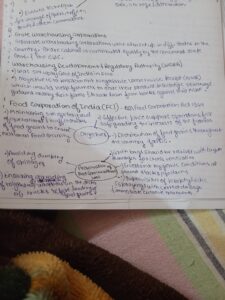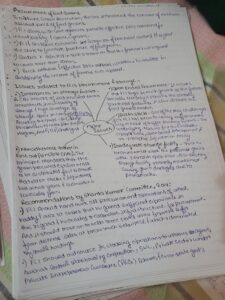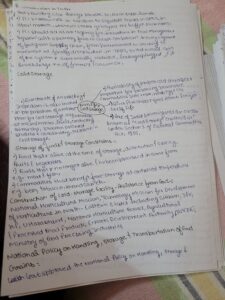Examine critically how intellectual property rights (IPR) may be abused, including through patent thickets and evergreening, and whether stricter antitrust laws are necessary to maintain fair competition.
Need for Harmonizing IPR Policies Across Jurisdictions The borderless nature of scientific and technological innovations poses significant challenges to Intellectual Property Rights (IPR) policies. Harmonizing IPR policies across jurisdictions is crucial for addressing these challenges and fosteringRead more
Need for Harmonizing IPR Policies Across Jurisdictions
The borderless nature of scientific and technological innovations poses significant challenges to Intellectual Property Rights (IPR) policies. Harmonizing IPR policies across jurisdictions is crucial for addressing these challenges and fostering a conducive environment for innovation. Here’s a detailed discussion of this need:
1. Challenges Posed by the Borderless Nature of Innovations
Scientific and technological advancements often transcend national borders, complicating the enforcement and management of IPRs.
Cross-Border Enforcement Issues: Innovations can easily cross borders, leading to difficulties in enforcing IPRs. For instance, software piracy and counterfeit products often involve international networks that can evade local jurisdictional controls.
Inconsistent Regulations: Differing IPR policies across countries can create inconsistencies and barriers for innovators. For example, patent standards and protection durations vary significantly between the United States and the European Union, complicating global patent management for multinational companies.
2. Recent Examples Highlighting the Need for Harmonization
Recent global events underscore the need for a more unified approach to IPR policies:
COVID-19 Vaccines: The development and distribution of COVID-19 vaccines highlighted the challenges of inconsistent IPR policies. Vaccine production faced barriers due to patent rights and licensing issues, leading to disparities in vaccine availability worldwide. Harmonizing IPR policies could facilitate better coordination and equitable distribution of critical health technologies.
Digital Content and Copyright: The global nature of the internet and digital content has led to issues with copyright enforcement. For example, the unauthorized distribution of digital media across borders remains a significant challenge. Harmonizing copyright laws could help address piracy and ensure better protection for creators and content providers.
3. Benefits of Harmonizing IPR Policies
Enhanced Global Trade and Investment: Harmonized IPR policies can facilitate smoother international trade and investment by reducing legal uncertainties and barriers. For example, consistent patent laws can simplify the process for companies seeking to protect their innovations globally, promoting international collaboration and investment.
Improved Enforcement and Compliance: A unified IPR framework would streamline enforcement mechanisms and improve compliance. This can help address issues related to counterfeiting and piracy more effectively. For instance, international cooperation on enforcement can enhance the ability of customs and law enforcement agencies to tackle cross-border IPR violations.
Encouragement of Innovation: Harmonization can create a more predictable and stable environment for innovators. A consistent IPR framework across jurisdictions can incentivize research and development by ensuring that intellectual property is protected uniformly, thus fostering innovation on a global scale.
4. Initiatives and Frameworks for Harmonization
Several international frameworks and initiatives aim to address IPR challenges through harmonization:
TRIPS Agreement: The Trade-Related Aspects of Intellectual Property Rights (TRIPS) Agreement, established under the World Trade Organization (WTO), sets minimum standards for IPR protection that member countries must adhere to. While it provides a baseline, further harmonization beyond TRIPS could address emerging challenges and disparities.
WIPO Initiatives: The World Intellectual Property Organization (WIPO) promotes global IP cooperation and offers frameworks for harmonizing policies. WIPO’s work on patent law treaties and copyright agreements aims to foster international consistency and collaboration.
Regional Agreements: Regional agreements, such as the European Patent Convention (EPC) and the African Regional Intellectual Property Organization (ARIPO), demonstrate efforts to create more unified IPR systems within specific regions, which can serve as models for broader harmonization.
In conclusion, harmonizing IPR policies across jurisdictions is essential to address the challenges posed by the borderless nature of scientific and technological innovations. By creating a more consistent and coordinated approach to IPR, we can enhance global trade, improve enforcement, and foster innovation, ultimately benefiting the global economy and society.
See less



The misuse of Intellectual Property Rights (IPR) can significantly impact innovation and competition, potentially leading to monopolistic practices and stifling of competition. Two prominent issues in this regard are "evergreening" and "patent thickets." Addressing these problems often involves theRead more
The misuse of Intellectual Property Rights (IPR) can significantly impact innovation and competition, potentially leading to monopolistic practices and stifling of competition. Two prominent issues in this regard are “evergreening” and “patent thickets.” Addressing these problems often involves the implementation of stronger anti-trust regulations and reforms. Here’s a critical examination of these issues and the need for regulatory interventions:
1. Evergreening
Definition and Practice
Evergreening refers to the strategy used by patent holders to extend the life of a patent beyond its original term through minor modifications or additional patents. This is typically done to maintain market exclusivity and delay the entry of generic competitors.
Pharmaceutical Industry: In the pharmaceutical sector, evergreening often involves minor changes to a drug’s formulation, dosage, or delivery method. For example, a pharmaceutical company might patent a new version of a drug with a different release mechanism, even if the therapeutic benefits are minimal compared to the original drug.
Technology Sector: In technology, evergreening might involve patenting incremental improvements or variations on existing technologies to prolong exclusivity.
Impact
Increased Costs: Evergreening can lead to higher drug prices and increased costs for consumers, as it delays the availability of cheaper generic alternatives.
Innovation Stifling: By extending patent protection through trivial modifications, companies may hinder genuine innovation and the development of new products.
Market Entry Barriers: It creates barriers for new entrants and smaller firms who may struggle to compete with established companies leveraging evergreening tactics.
2. Patent Thickets
Definition and Practice
Patent thickets arise when multiple overlapping patents cover a single technology or product. This creates a dense network of patents that can complicate the development and commercialization of new products.
Technology Licensing: Companies may face difficulties in navigating these thickets to obtain necessary licenses, leading to increased costs and legal uncertainty.
Innovation Barriers: Startups and smaller firms may find it challenging to enter markets due to the complexity and cost of obtaining licenses for multiple patents.
Impact
Increased Transaction Costs: Navigating patent thickets can significantly increase the transaction costs for companies seeking to develop new technologies.
Litigation Risk: Companies may face an elevated risk of patent infringement lawsuits, which can be costly and time-consuming.
Reduced Innovation: The complexity and cost associated with patent thickets may deter investment in research and development, thereby slowing technological progress.
Need for Stronger Anti-Trust Regulations
To address the issues of evergreening and patent thickets and ensure fair competition, stronger anti-trust regulations and reforms are necessary. Here’s how these regulations can help:
**1. Anti-Trust Regulations and Competition Law
Preventing Abuse of Market Power: Anti-trust laws can prevent companies from abusing their patent rights to maintain monopolistic control over markets. Regulations should address practices that unfairly extend patent protection and hinder competition.
Promoting Generic Competition: Anti-trust regulations can facilitate the entry of generic and biosimilar products by curbing practices like evergreening that delay market entry. Policies should encourage timely approval of generics and biosimilars.
Addressing Patent Thickets: Regulations can address the issue of patent thickets by promoting transparency in patent ownership and encouraging the simplification of patent portfolios. This can reduce the complexity and cost of navigating patent landscapes.
**2. Patent Reform
Stricter Patent Criteria: Reforming patent criteria to ensure that patents are granted only for genuine innovations and not trivial modifications can help combat evergreening.
Patent Duration Adjustments: Revising the duration of patent protection or introducing mechanisms to review and challenge overly broad or frivolous patents can mitigate the impact of evergreening.
Streamlining Patent Processes: Simplifying patent filing and litigation processes can help reduce the barriers associated with patent thickets and promote more efficient technology development.
**3. Transparency and Access
Patent Transparency: Enhancing transparency in patent filings and ownership can help stakeholders better understand the patent landscape and reduce the risk of inadvertently infringing on overlapping patents.
Access to Licensing: Encouraging fair and reasonable licensing practices and promoting open innovation models can help facilitate access to essential technologies and reduce the barriers posed by patent thickets.
Conclusion
The potential misuse of Intellectual Property Rights through evergreening and patent thickets presents significant challenges to fair competition and innovation. Evergreening can lead to increased costs and hinder genuine innovation, while patent thickets complicate the development of new technologies and create legal and financial hurdles.
Stronger anti-trust regulations, patent reforms, and increased transparency are essential to address these issues. By implementing such measures, governments and regulatory bodies can help ensure a more competitive and innovative marketplace, foster fair competition, and enhance access to essential products and technologies.
See less